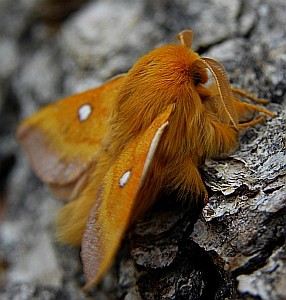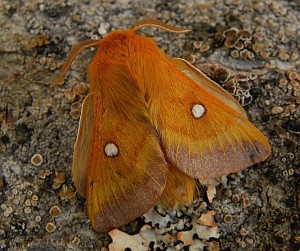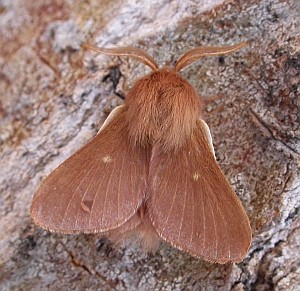Eastern Eggar Eriogaster catax (Linnaeus, 1758) in Liébana
Teresa Farino
08/12/2010 11:03:13
New Cantabrian locality - only the third in the province - for this scarce lasiocampid moth.
Posted in: Butterflies and Moths, Endangered Wildlife and Habitats | Cantabria | Mainland Spain, Northern Spain
 Male Eastern Eggar
Male Eastern Eggar
Eriogaster catax© Teresa FarinoIn mid October 2010, José Manual Sesma, the Director of Insectarium Virtual – a fabulous resource for Spanish entomologists – wrote to me asking if I had any images of the Eastern Eggar Eriogaster catax (Lasiocampidae) with which to illustrate a publication about Iberian species listed on the EU Habitats Directive, which is currently being prepared by Spain’s Ministerio de Medio Ambiente.
My response was that, although I’d been moth trapping in Liébana and the Picos de Europa since 1989, I had never once come across this enigmatic little moth, despite the fact that my study area lies within the supposed range of the species in Spain.
You can imagine my excitement, therefore, when at 22.30 on 22 October 2010, British moth enthusiast Matthew Gandy and I observed a fabulous male of the species basking on the wall behind the Robinson trap on my terrace, in Liébana, western Cantabria. But why hadn’t I ever caught one before?
A search of the literature reveals that the Eastern Eggar is essentially a central and southern European species whose range extends as far east as the Urals, with northern Spain at the extreme western limit of its range. In Spain it has been recorded only in the extreme north, from Cantabria to Catalunya, and apparently, in mild autumns, it can be quite abundant in some parts of the eastern Pyrenees. The adult moths appear in a single generation, with the flight period ranging from September to late October.
 Male Eastern Eggar
Male Eastern Eggar
Eriogaster catax© Teresa FarinoIn Spain, Eriogaster catax typically occupies clearings and woodland margins in deciduous and coniferous forests, preferentially on limestone, within an altitudinal zone ranging from 500 to 1500m above sea level. Its stated larval food plants include species of Crataegus, Quercus, Prunus, Betula, Ulmus, Berberis and Populus, with Small-leaved Elm (Ulmus minor), Blackthorn (Prunus spinosa), Hawthorn (Crataegus monogyna) and even Doryncium pentaphyllum typically utilised by the larvae in northern Spain.
Eastern Eggar is included in Annexes II and IV of the EU Habitats Directive, but owing to the paucity of records of this species in Spain, in the 2008 Atlas de los Invertebrados Amenazados de España, published by the Ministerio de Medio Ambiente, its status is listed as ‘Datos Insuficientes’ (Data Deficient), in accordance with the IUCN category.
At a local level, Eriogaster catax is cited in the Catálogo Regional de Especies Amenazadas de Aragón (1995), and in the Libro Rojo de las Especies Amenazadas del Principado de Asturias, despite not ever having been recorded in this autonomous community. It is not, however, included in the Catálogo Regional de Especies Amenazadas de Cantabria, despite there being a previous record of the species from Fuente Dé, in the Liébana LIC (Site of Community Importance) and the Picos de Europa National Park.
 Male Autumnal Eggar
Male Autumnal Eggar
Eriogaster rimicola© Teresa FarinoA quick trawl of the Spanish data reveals just 36 localities for the Eastern Eggar, more than half of which are in Aragón, originating from both the Alpine and Mediterranean bioclimatic regions. The species appears to be much rarer in Spain’s Atlantic habitats, with the westernmost record being that from Fuente Dé, on the southern edge of the limestone massifs of the Picos de Europa. Prior to the appearance of the moth on my terrace on 22 October 2010, the only other known locality for Eriogaster catax in Cantabria was the Puerto de Pozazal, south of Reinosa.
One of the reasons proposed for the scarcity of the Eastern Eggar is the high level of parasitisation and microbial pathogens suffered by its caterpillars, which obviously lead to a reduced number of adult moths. This state of affairs is shared by its congener, the spring-flying Small Eggar Eriogaster lanestris – another species that I have yet to encounter in the Picos de Europa – although the third Spanish third member of the genus, Autumnal Eggar Eriogaster rimicola, appears to be fairly abundant here (see image on the right for comparison).
On the other hand, the paucity of systematic moth recording in northern Spain has undoubtedly contributed to the lack of records for this species, and it may well be that an increase in funding for studies of this nature might reveal the Eastern Eggar to be more widely distributed than is currently thought, particularly in the Atlantic zone.
Don’t forget that in Spain it is ILLEGAL to use a butterfly net or moth trap without a permit from the relevant authorities, even if you do not take specimens.
Read more blog posts